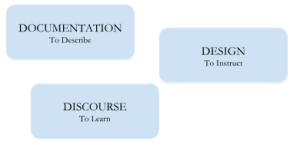This post is in response to a wonderful post by Derek Pinchbeck. He asked some thoughtful questions at the end and this is my way of trying to answer one of them. Cross posted at The Lead Learner.
How much choice do your students have about how and what they learn?
I like this question. When working within a system like PYP, sometimes I feel as if the UOI are too limiting. Then, we create a unit that really blows that idea out the door and lets kids explore and play and inquire.
EARLY LEARNING
SYSTEMS; How we organize ourselves
CENTRAL IDEA, Systems can make life more efficient
LINES OF INQUIRY; A system is a way of organizing (form, function), Systems can direct how we act and go places (connections)
This unit was very broad and open. The knowledge and content was not dictated. It was driven by concepts. The teacher who was leading this class (the teacher is the Lead Learner of a collective) was open-minded and allowed the unit to flow with the children, rather than against them.
It ran for most of the year, along side another unit on CHANGE (which crossed over and linked many times, but that is another post). The kids started looking into class routines and how they were systems designed to make the classroom run more smoothly. They then applied these to the school at large. From there, they went out into the world. They looked at postal system, traffic, trains, buses (all locally connected to Kyoto and Japan). They inquired into gardening, sports, recycling. They ended up in space learning about the solar system, how the planets move, and what life on the international space station is like.
There were many more provocations and places where this unit went.
They created systems to play in (sharing routines, centers, etc). They pretended they were buses drivers and pasted bus stops all over the classroom (trains too). They were postal officers delivering mail. They went on a recycling spree and cleaned up the school, separating garbage into different types. They created a class garden with systems to care for plants. They looked into the human body and how it works. They turned their classroom into an international space station.
Literacy, math, art, science, etc… all weaved into this. Creating stories, writing letters, doing math in the garden, practicing fine motor skills, etc, etc, etc. Within this is choice, how the students are going to represent their learning, what they are going to do. Sometimes, the child gets to choose, other times they do not. There are skills to practice, and it is the teachers responsibility to provide a space for them to practice these skills. For the most part, students, even very young ones like these, can understand that learning these skills are an important part of their learning.
This unit was all based on the students interests. They noticed systems and named them, expressed their interest, and the teacher framed it into educational goals. We need to have students driving the bus (so to speak) and taking charge or their learning. We need to have the inquiry to be child-directed.
However, we also need the teacher to be framing this into the appropriate skills and curricular expectations. There is an article in The Hundred Languages of Children (Chapter 14, Negotiated Learning through Design, Documentation, and Discourse, Forman & Fyfe) which has been fundamental in the way we approach our Early Learning program.
THE CURRICULUM IS CHILD-ORIGINATED AND TEACHER FRAMED (pg 248, Forman & Fyfe)
Through the Design of the environment and the learning tasks, the Documentation of the learning that is happening, and the Discourse that the students (and teachers) are having, the teacher can frame and let the inquiry evolve.
I don’t use the word play as much as I used to. To me, it is inseparable from learning. However, it doesn’t mean that the teacher isn’t involved and the children are free to do what they wish. The teacher is very involved. The teacher listens, reacts, adapts, and then frames (or re-frames). We design learning engagements (taken right from the students discourse) that encourage discourse and then document the learning. This discourse creates newly designed provocations, which are in turn documented.
It is iterative and ever-evolving.
How much choice to students have? Well, choice is a simplistic word that does not represent the complexity of a classroom learning environment. Choice is negotiated, adapted, and re-framed.




I’m doing a similar unit with my 3 year olds and was wondering how I can introduce the word “system” to them and what provocations should I use. I am going to do the systems that only relate to them.
I would really appreciate if I got some ideas from you since you have successfully run the unit. Thank you in advance.
LikeLike
Start with the physical environment. Bring attention to the class systems in place for going out to recess, getting lunch ready, etc. Once they know that these are systems designed to make the class more efficient, move outside the classroom to school systems. Then out to the neighborhood, traffic lights, sidewalks, post office, trains. Let them play with systems, change them, imagine new ones, modify. Socio-Dramatic play is a great way to see what they are learning. Here are three steps to help:
1) Set up the class as a place that will invite socio-dramatic play and systems (turn it into a fire station or a post office or an international space station). In the example above we set it up as ISS and did some thinking beforehand about what they believe happens on a space station. We used pictures and videos to aid their thinking.
2) Let them play. Take notes about their behaviors and their misconceptions. After the initial thinking we said, “ok, lets play space station”. We didn’t give specific rules or roles, just wanted to see what they would do.
3) Set parameters (rules, constraints) that will target certain areas and allow their knowledge and experience of the system to grow and evolve. Next we targeted certain areas, food preparation, safety suits, etc. This filled in a lot of holes in their knowledge and let their play be a lot more in depth. We did this in centers or groups, and then they shared what they learned with the class.
We run our early learning units for the entire year to let it build on itself and grow. If you don’t do that, pressure your admin to change. Once you go with a year long unit in Early Learning, you will never go back!
LikeLike